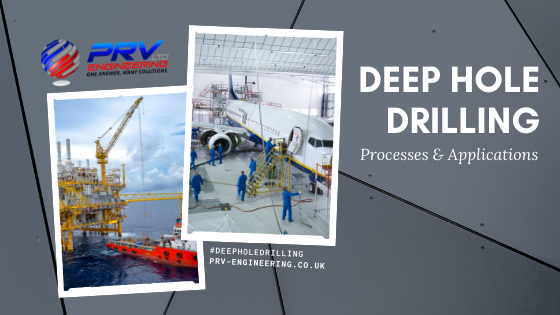
Deep hole drilling measures the distribution of stresses along the axis of a drilled hole. This process is unique in that it can measure residual stresses at a microscopic level with a penetration of over 750 millimetres (30 inches), without completely destroying the original component. Compared to other drilling techniques like centre hole drilling, DHD is considered deep.
Deep Hole Drilling Processes
Deep hole drilling uses special tools and setups to deliver high-pressure coolant, cleanly evacuate chips while achieving depth-to-diameter holes beyond what a typical CNC machine can do. This means manufacturers can reliably, accurately and efficiently achieve tolerances and production requirements.
There are several deep hole drilling processes including BTA drilling and gun drilling with additional processes specially designed for specific tolerances. These are typically performed on BTA-style deep hole drilling machines.
BTA Drilling
BTA deep hole drilling is commonly used for larger holes, around 20 – 200 mm [0.80 – 8.00 in] in diameter with high-pressure coolant around the outside of the tool. Chips are pushed through the tool centre, drill tube and machine spindle. BTA drilling is usually 5-7 times faster than gun drilling and requires a higher power output. Counter-boring can assist BTA machines as a secondary deep hole operation to drill extended diameters.
Gun Drilling
Gun drilling, on the other hand, is used to drill smaller holes usually 1 – 50 mm (0.04 – 2.00 inches) in diameter. Once more, high-pressure coolant is introduced through the spindle and centre drill. The cutting tool is a fluted solid rod with a bored hole in the centre where the coolant is injected through a hole in the middle. From there it flows back outside, through the flute and brings the chips with it.
Common Deep Hole Drilling Applications
Deep hole drilling is used on a variety of materials including the basic aluminium to super-alloys. It is capable of achieving extremely tight diameter control, straightness and superior surface finish. For that reason, DHD is more common in oil and gas exploration equipment, armaments, aerospace equipment and engines.
Each of these industries requires exact precision with extreme reliability. Here are some examples of where deep hole drilling plays a major role:
- aircraft landing gear
- driveshafts
- fuel injector bodies
- fuel rails for diesel engines
- heat exchanger tube sheet
- fluid assembly ends
- steering columns
- hydraulic rams
- hydraulic cylinder inside bore
- oilfield exploration equipment
- oilfield downhole exploration
- plate rolls
- injection mould tools
Interesting Read: ‘How Oil & Gas Robotics Are Shaping The Future’
Advantages Of Deep Hole Drilling
The advantages of DHD far outweigh the disadvantages compared to other residual stress measurement techniques.
- Semi-destructive which enables repeated stress measurements at different stages
- The equipment required is portable enough to use on-site or in a laboratory
- A through-thickness bi-axial residual stress distribution is measured including stress gradients
- Incremental DHD can measure high magnitude residual stresses, accounting for plasticity
- Applicable to simple and complex component shapes
- Applicable to a wide range of metallic and non-metallic materials
- Counter-rotational drilling is best for accuracy
- The DHD process is fast, relative to the quantity of information produced
- The extracted cylinder of material provides stress-free sample allowing for further tests and validations
Disadvantages of DHD extend to the fact that it’s semi-invasive. This means the hole might need to be re-filled or you need to provide a mock-up. DHDis also not applicable through components that are less than 6 millimetres (0.24 inches) thick.
Conclusion
Deep holes are present in various applications where each one has its own set of strict requirements and unique challenges. Some might need tighter tolerances, tougher materials or a higher production goal. Considering the scope of practice, deep hole drilling requires the expertise only a few engineering companies can offer.
PRV Engineering can manage all of your deep hole drilling requirements as they deliver a “complete, customised service”. As one of Europe’s top suppliers of precision engineering services, they continue to invest heavily in acquiring and training highly skilled staff and state-of-the-art machinery.
Get in touch with PRV if you need help with a manufacturing project of any shape or size. They can manufacture products in all materials from the most basic mild steels to the more exotic Monel, Inconel, Hastelloy and Titanium.
This site uses Akismet to reduce spam. Learn how your comment data is processed.


 Mail:
Mail: 




Leave a Comments